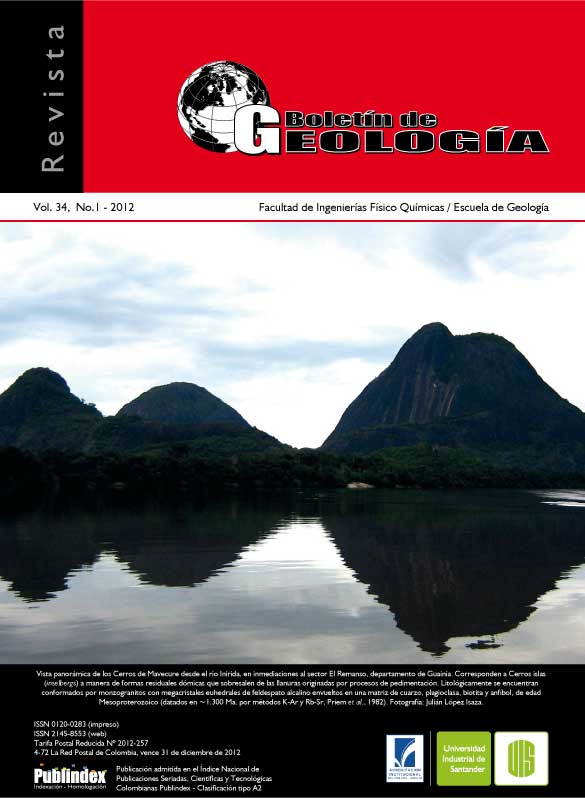INFLUENCE OF THE MINERAL COMPOSITION OF CLAY ROCKS IN THEWELLBORE STABILITY
Published 2012-08-24
How to Cite
Abstract
In the oil companies, the operation of drilling wellbore could be more expensive if the composition of the rocks is clay, the cost could increase between 10 and 15% from the starting budget. In order to decrease this problem, the oil industry has spent too much money for developing mechanisms that can provide better controland stability in clay formations during the drilling. The Society Petroleum Engineers (SPE) in some researches have published that the main chemical effects that are involved in the interaction of perforation fluids and the clay formation are: 1) chemical osmosis; and 2) hydration stresses, although, there are others like: Capillary effects, dehydration, differences in pressure and cationic exchange. These factors are not present generally in independent form. At “Piedemonte Llanero” the problem of the wellbore stability represents a high spending of money for oil companies, caused in this region by chemical factors between fluid/rock and mechanical factors as resulted of the stresses in the area. Metil Blue Testing (MBT) and X-ray Difraction (DR-X) were made in samples of clay; these were taken from cuts extracted of boreholes drilled in some places of the Colombian Llanos. It was found that these samples had a moderate content of reactive and low content of swell minerals.The samples main component was kaolinite, this mineral does not let the rock get swell, but it produces cavingin the hole. However, it is necessary to do other tests to quantify the damages and evaluate the influence of there gime of the stress during the perforation of wellbore.
Keywords: Wellbore, Instability, Clay minerals, “Piedemonte Llanero”.
Downloads
References
Adesoye, K. 2009. Shale Characterization for Evaluating Shale-Drilling Fluid Interaction. University of Oklahoma. Master of Science Thesis, 122p
Amorocho P.R. 2003. Análisis de la Interacción Química entre los Fluidos de Formación, Perforación y Composición Mineral de Rocas Arcillosas en la Estabilidad de Pozos. Universidad Industrial de Santander. Escuela de Geología. Trabajo de grado, 94p
Bol, G.M., and Wong S.W. 1974. Borehole Stability in Shales. Article SPE 24975. 444 (1920): 161-184
Brandon, B.D., Cerkovnik, J., Eastman, C., Koskie, E., Colston, F., Anderson, M.E., Hollister, K.T., Senger, J., and Niemi, R. 1992. Development of a New IADC Fixed Cutter Drill Bit Classification System. SPE Paper No. 23940. SPE/IADC Drilling Conference, 841p
Bustos, D.E., y Enoc, O. R. 1967. Restauración Teórico – Práctica del Laboratorio de Lodos y Cementos. Escuela de Ingeniería de Petroleos. UIS, 98p
Cress, L.A. 1983. How and When To Run a PDC Bit in the Upper Texas Gulf Coast-An Operator’s Viewpoint. SPE Paper No. 11388 presented at the IADC/SPE 1983 Drilling Conference, 255p
Fam, M.A., and Dusseault, M.B. 1999. Borehole Stability In Shales: A Physico-Chemical Perspective. Article SPE 47301: 461-463
Govea-Rodriguez, C., y Aguilera, H. 1985. Cuencas Sedimentarias en Colombia. II simposio Bolivariano de Cuencas Subandinas. ACGGP, Bogotá, pp. 1-93
Grim, E. R. 1962. Clay Mineralogy. New York, 422p
Guizhong C., Martin E. C., Mukul M. S., and Mengjiao Y. 2003. A Study of Wellbore Stability in Shales Including Poroelastic, Chemical, and Thermal Effects. Journal of Petroleum Science and Engineering, 38: 167-176
Kubacki, W. 1981. Alteración de la Caolinita como la Causa de la Reducción de Permeabilidad Natural de la Formación. Instituto de Investigaciones Petroleras. Universidad del Zulia. Facultad de Ingenieria. Maracaibo, Venezuela, 10p
Lingdong L., Yuanfang C., Yuting Z., Qing C., and Fengkun Z. 2011. A Fluid-Solid Coupling Model of Wellbore Stability for Hydrate Bearing Sediments. Procedia Engineering, 18: 363-368
Moreno, R.H., y Antolinez, V. 1989. Análisis del Lodo Polímetro Ez-Mud para Estabilidad de Lutitas. Universidad Industrial de Santander. Escuela de Ingeniería de Petróleos. Bucaramanga. Trabajo de Grado, 115p
Pérez, V. 1985. The Apiay Block, Llanos Basin. II Bolivarian Symposium Oil Exploration in Subandean Basin. Part Two. Geological Field Trips Colombia (1980). Ecopetrol, pp. 213- 229
